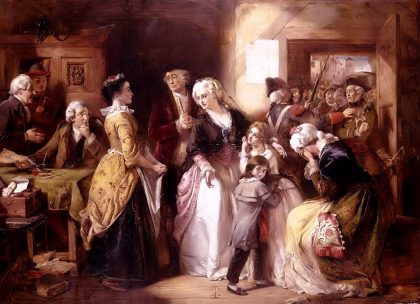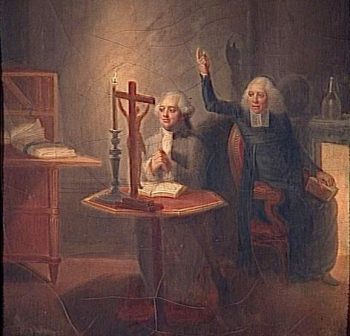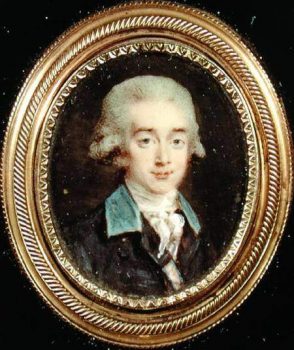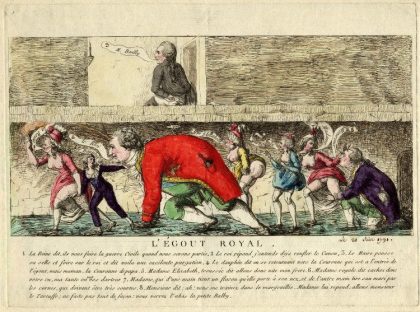Why Was the French King and His Family Arrested

The flight to Varennes describes the regal family'due south failed attempt to escape their house arrest in Paris in June 1791. They were located and detained the post-obit day and returned to the majuscule. The flight to Varennes was a turning bespeak in the French Revolution because it exposed the untrustworthiness of the rex and the unworkability of the newly implemented constitution.
Overview
Appalled past the growing radicalism of the revolution, particularly its attempts to regulate and control the church, Louis Xvi agreed to abscond from the city. The plan, hatched by Count Axel von Fersen and supported by Marie Antoinette, was to travel by coach to Montmedy, a fortress nigh the High german edge garrisoned by royalist troops.
Despite a series of blunders, the royal entourage escaped Paris and travelled to within 30 kilometres of its goal. At Varennes, the king was recognised and identified by a local postmaster. Louis and his family were promptly detained and hustled back to Paris under guard.
The flight to Varennes, though pocket-sized in itself, signed the death warrant for bourgeois dreams of a French constitutional monarchy. The king had attempted to flee the revolution and could no longer be trusted. His working alliance with the National Constituent Assembly and his acceptance of the Constitution of 1791 were exposed equally fraudulent.
Why did the rex abscond?
A number of factors caused Louis Sixteen to lose whatsoever organized religion he had in the revolution. One was the advice of Honore Mirabeau.
At the Estates-General two years earlier, Mirabeau had seemed an arch-radical, defiantly proclaiming that the National Associates would simply disperse at the betoken of bayonets.
Mirabeau's political vision for France, still, was fundamentally conservative. Mirabeau favoured a strong monarchy with some of the male monarch'southward capricious powers checked past a constitution and a legislative assembly. If the monarchy savage, Mirabeau believed, the revolution would collapse into leaderless chaos. Stripping the king of his powers would alienate him from the revolution and lead information technology to failure.
To avoid this, Mirabeau became a virtual double agent. In May 1790, he signed a undercover bargain with the crown, agreeing to work for the king's benefit in the National Constituent Assembly.
Mirabeau'southward informational notes to the male monarch, discovered after his death in April 1791, were comprehensive and astute. Past early 1791, Mirabeau was advising Louis to relocate to Rouen or some other provincial upper-case letter; once there he could rally support, appeal to the people and lead a national revolution, free of the dark influences in Paris. While he distrusted Mirabeau, the rex seemed to accept his communication about retreating from Paris.
The rex'southward piety

Some other cistron in Louis' decision to flee Paris was his devout religious organized religion. The king was appalled past the Civil Constitution of the Clergy and its implications for the church building in France. The Assembly had passed the Civil Constitution in July 1790 merely Louis delayed signing it until December, hoping for a public outcry or an intercession from the Vatican.
Privately, the king refused to attend any Mass given by a constitutional priest, believing this might endanger his immortal soul. Instead, he regularly attended Mass at a small chapel in the Louvre, where the service was performed by refractory or non-juring priests.
A minor controversy arose in April when the king learned he would be expected to attend a public Easter Mass at Saint-Germain l'Auxerrois, besides at the Louvre. This would hateful receiving communion from a constitutional priest.
Seeking to avoid this, the rex and his family planned to leave Paris on April 18th and spend Easter at their summer house at Saint-Cloud. They were prevented from leaving the Tuileries by a hostile mob, which trapped their wagon in a courtyard for two hours, hurling insults and projectiles. This incident just confirmed what most already suspected: that the king and his family were virtual prisoners in Paris.
The escape program

The program to flee Paris in June 1791 was largely concocted past Alex von Fersen, a Swedish aristocrat, military leader and diplomat.
Fersen, a regular visitor to France from the late 1770s, had become a favourite of Marie Antoinette. It is often said that Fersen and the queen were lovers, however, bear witness for this is circumstantial. What is more than certain is that Fersen was operating with the financial backing of Sweden's Gustav Iii, who wanted the French royal family to escape the dangers of Paris.
In May 1791, Fersen devised a complicated escape program that involved leaving the Tuileries through unguarded doors, changes of clothing, false passports, bodyguards, a taxi carriage through the backstreets of Paris and a planned exchange of carriages on the city's outskirts.
Outside Paris, the male monarch and his family would run into a platoon of Hussars and make their fashion to Montmedy, a fortress in north-eastern France manned past loyal soldiers. The distance betwixt Paris and Montmedy was around 200 miles (325 kilometres). Fifty-fifty at full speed, such a journey would take an entire twenty-four hours and require around xx stops for fresh horses.
Issues arise
Fersen's scheme proceeded as planned on the evening of June 20th – just it was beset by a number of problems and delays.
The male monarch'southward escape was delayed past a nighttime visit from the Marquis de Lafayette and Jean-Sylvain Bailly, who kept him talking longer than expected. Marie Antoinette left the Tuileries as planned but spent several minutes wandering lost in the streets outside, before eventually locating her railroad vehicle.
Once underway, the king's entourage was forced to take a longer route out of Paris than originally planned. It was farther delayed about the metropolis gates past a hymeneals party.
All these delays put and so at least 90 minutes behind schedule. Another hour was lost most Châlons when the king's railroad vehicle cruel and damaged its harness sometime around dawn on June 21st. By this stage, the escape political party was some iv hours backside schedule – but with around one-half the journey to Montmedy completed, the royals were confident their plan would succeed.
The plot exposed
Dorsum in Paris, the king's escape was discovered around the time he was passing Châlons. A contingent of National Guard was immediately dispatched in pursuit of the imperial family.
Word of the royal flight chop-chop spread around the city, prompting an aroused reaction. Conspirators claimed the king'due south disappearance was testify of a looming counter-revolution or strange invasion. Some accused high ranking city officials, including Bailly and Lafayette, of assisting the royal family to escape.
Meanwhile, the king'due south coach proceeded on its journey and reached Sainte-Menehould, effectually fifty miles (80 kilometres) from Montmedy. While stopped there they were identified past the local postmaster, Jean-Baptiste Drouet who, according to fable, recognised the king from his portrait on a money or assignat.
Drouet allowed the royal party to keep but raised the alarm, leading to the royal family unit being stopped at Varennes, 20 miles (32 kilometres) n of Sainte-Menehould and 31 miles (50 kilometres) short of their destination.
The king was arrested at 11pm on June 21st and dispatched back to Paris at 7am the following morning. A big contingent of Royalist troops arrived as the rex's railroad vehicle was near to depart Varennes. These troops contemplated an assault to rescue Louis – only fearing the male monarch and his family would be massacred, they refused to attack.
Reactions

The king's failed endeavour to escape Paris was dubbed the flying to Varennes (something of a misnomer given the existent objective of his flight was Montmedy).
Whatever public affection the king had enjoyed in early 1791 was shattered by the events of June 20th and 21st. The royal family was returned to Paris and reinstalled at the Tuileries Palace, this time under a more than visible guard.
Their failed adventure triggered a rush of crude propaganda that ridiculed the royals and their fumbling escape endeavor. The Paris sections and radical journalists demanded the immediate abolition of the monarchy and the creation of a republic. Some went farther and insisted the male monarch exist put on trial for treason against the constitution.
Many were stunned not but by the king'southward try to flee – but how the National Elective Assembly responded to it. Jerome Pétion, the Republican politician who later on became mayor of Paris, was amazed at the reception afforded the rex on his return to the urban center. His Majesty was treated, as Pétion noted, similar nothing had happened:
"After a few minutes, we moved [to] the king's apartments. Already all valets were in attendance, wearing their usual court apparel. Information technology seemed every bit if the king had merely returned from a hunting expedition, and everyone was profitable him with his toilet. In seeing the king, in observing him closely, information technology was incommunicable to gauge that something momentous had just happened. He was so phlegmatic and tranquil, as if aught was out of the ordinary. He immediately resumed his state of representation. It was as if those around him thought that he had returned dwelling house afterwards a few days' absence. I was perplexed by what I saw."
Political ramifications
The question of what to do with the king after Varennes widened the gulf betwixt political moderates and radical republicans.
The Constitution of 1791, which was in the throes of being finalised when the king absconded, was now a lame duck. The king had spent 2 years mouthing back up for the constitution merely his actions in June 1791 showed simply contempt for it. Bourgeois dreams of a harmonious constitutional monarchy were shattered; the progress made since 1789 appeared to accept been lost.
Yet again, the new authorities was faced with the claiming of reinventing national government.
A historian's view:
"The flight to Varennes opened upwards the second great schism of the revolution. There had been hardly whatever republicanism in 1789, and what there was had abated once the rex was back in Paris and accepting all the Assembly sent to him. Just later on Varennes, the mistrust congenital upwardly by his long record of apparent ambivalence outburst out into widespread demands from the populace of the capital and a number of radical publicists for the king to be dethroned."
William Doyle

ane. The flight to Varennes refers to a failed endeavour past King Louis 16 and his family unit to escape from revolutionary Paris in June 1791.
2. Factors behind the king'south conclusion to flee included his lack of faith in the revolution and the Constitution of 1791, his personal religious behavior, advice from Mirabeau and urging from his wife.
3. The escape was planned over the preceding calendar month by Count Axel von Fersen, a Swedish general and favourite of Marie Antoinette, who planned to sneak the imperial family out of Paris to the loyalist stronghold at Montmedy, in north-eastern France.
4. The imperial family'due south escape attempt encountered several delays that put them hours behind schedule and contributed to their eventual discovery and arrest.
5. The male monarch and his family unit were arrested at Varennes and returned to Paris. While the National Assembly took no firsthand action, radicals demanded the abolition of the monarchy and the formation of a democracy.

Princess Marie-Thérèse's business relationship of the flight to Varennes (1791)
A notation left by Louis XVI after fleeing Paris (1791)
Louis Sixteen on his motives for the flight to Varennes (1791)
De Bouille on his role in the flight to Varennes (1791)
The Assembly responds to the flying to Varennes (1791)
Henri Grégoire on the flight to Varennes (1791)
Hébert on the flying to Varennes (1791)
Commendation information
Championship: "The flight to Varennes"
Authors: Jennifer Llewellyn, Steve Thompson
Publisher: Alpha History
URL: https://alphahistory.com/frenchrevolution/flight-to-varennes/
Date published: September 30, 2019
Appointment accessed: Feb 18, 2022
Copyright: The content on this folio may non be republished without our express permission. For more information on usage, please refer to our Terms of Employ.
Source: https://alphahistory.com/frenchrevolution/flight-to-varennes/
0 Response to "Why Was the French King and His Family Arrested"
Post a Comment